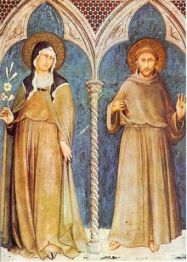 We had great plans for a storytelling pilgrimage on the first Sunday in October, which this year (2020) was also the Feast of Saint Francis and the final day of Creationtide, and yet the wind and rain had plans of their own! Not that Wild Church minds a bit of weather, but dragging dear Glynis and her Celtic harp around the countryside would have been most unkind, so we opted to start with our storytelling at St. Mary’s and then take a wander and wonder afterwards to let the inspiration of words and music settle into our souls.
We had great plans for a storytelling pilgrimage on the first Sunday in October, which this year (2020) was also the Feast of Saint Francis and the final day of Creationtide, and yet the wind and rain had plans of their own! Not that Wild Church minds a bit of weather, but dragging dear Glynis and her Celtic harp around the countryside would have been most unkind, so we opted to start with our storytelling at St. Mary’s and then take a wander and wonder afterwards to let the inspiration of words and music settle into our souls.
It still feels strange to gather masked and socially distanced and yet it is also a blessing to be able to come together in person. Glynis helped us to leave behind for a while the pressures of living with Covid, as she played a selection of Italian Laude from the Laudario Di Cortona, which is contemporary with St. Francis. This haunting and evocative music spirited us back into the thirteenth century and as Helen and I began to tell the story of Clare and Francis, I tried to imagine that I was not in a Victorian gothic church of St Mary in Dartington but in the much older sacred space of the church of San Maria Maggiore in Assisi. This is where Francis was baptised and I imagine Claire’s mother, Ortolana, also praying here for her daughter and perhaps it was Mary who inspired her to name her daughter, Chiara, which means brightness.
Often the story of these beginnings of Franciscan spirituality is told mainly from the perspective of the men – the fathers, sons, Bishops… and especially Francis himself. Yet dig a little deeper into the history and it seems to me that the friendship between Clare and Francis, the mutual inspiration and encouragement they shared and the courageous initiatives they both undertook throughout their lives, lie at the heart of what perhaps we could call the Franciscan and Chiaran way, one of spiritual brightness.
Both grew up in well off families and each had their own powerful moment of renunciation of their inherited wealth, power and privilege. Francis led the way in 1206, stripping off his fine clothes outside the Cathedral, renouncing his worldly inheritance and dedicating himself to God, to ‘Lady Poverty’ and the life of a poor pilgrim. Clare was about 12 years old at the time of this dramatic and no doubt much talked about incident. Later in her teens, Clare was inspired by Francis’ preaching during Lent and by eighteen years old she made her own renunciation, refusing to present herself to the Bishop as a marriageable maiden and instead running away from her family home with her sister to join Francis and his monastic brothers. Clare’s monastic vows would be the start of a cloistered life for her, filled with caring for others, while Francis would travel widely and be a healing guide for people and creatures. Yet both also built up monastic orders around them and Clare went on to become the first woman to write her own monastic Rule, setting out a wise and loving way of monastic living for her spiritual sisters.
There were many moments of inspiration in listening to the stories of Clare and Francis, and a deep sense overall of being encouraged by them to respond to all aspects of life with kindness, seeing all as sisters and brothers, including those who may be hard to love (‘Brother Trump’ was mentioned in this regard!) This way of looking at life felt very present within our pilgrim flock as we walked silently through the local lanes, appreciating all the diversity met along the way, from a bramble in the hedgerow to the great pine trees at the top of Yarner Beacon. As we walked along Bidwell Brook, sat on the earth and old leaves on the hill, watched the clouds and sensed the touch of the wind, it was easy to imagine Francis and Clare singing to Sister Water, Brother Wind and Mother Earth and praising God in all things.
